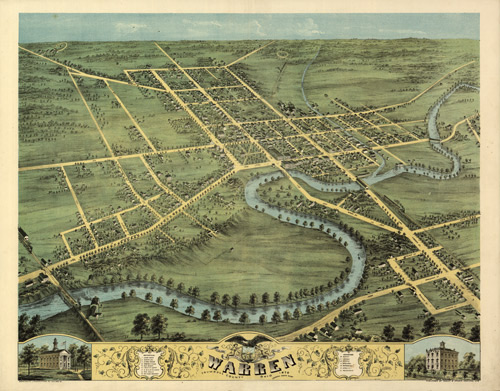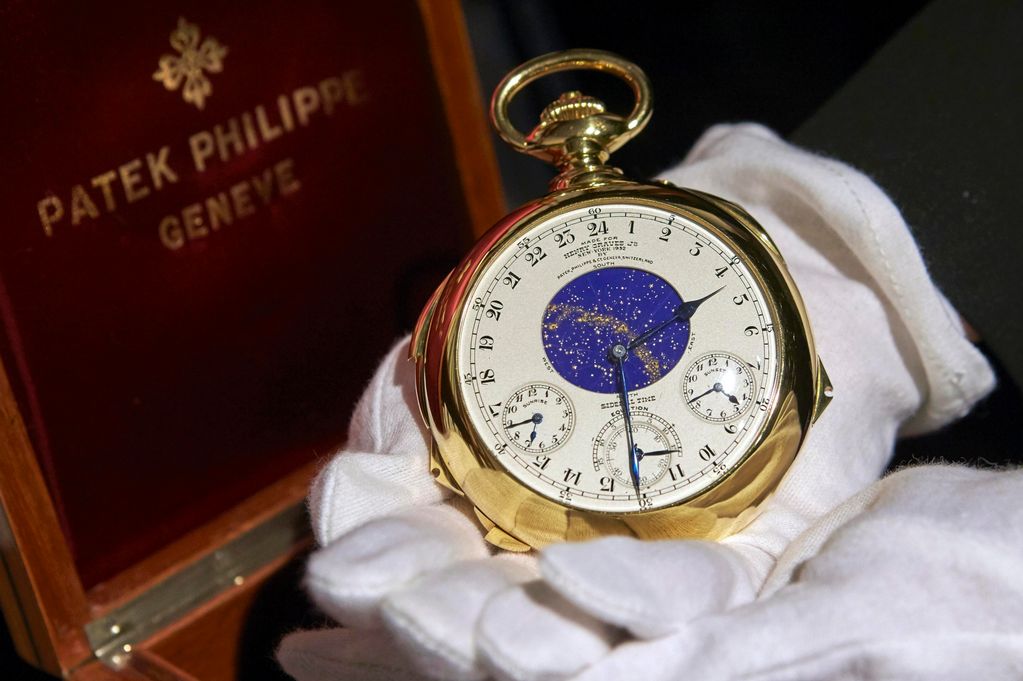The starscape on view from James Ward Packard’s window in Warren, Ohio, was magnificent.
In the summer, Draco, the dragon, would have wheeled above, clawing at Ursa Minor. Gemini would have ridden across Clinton Street and up the old Canal as Ursa Major reared and fell. And, with the help of his powerful, handmade, bespoke watch, Packard would have been able to plot the locations of all these constellations and more.Packard – he of the Packard Motor Car Company and Packard Electric Company – was a watch collector and an amateur astronomer. Like so many rich men in that era, he wanted the best of the best and he was in competition with Henry Graves, a New York millionaire with a watch fetish. A few hundred miles separated these two millionaires – Packard in Warren, Ohio, and Graves in Manhattan – but they both swore to have the most complicated watches in the world. Described in the beautiful book A Grand Complication, their friendly rivalry resulted in the apex of the watchmakers art when, in 1927, Packard announced delivery of his Vacheron Constantin grande complication (or supercomplication), a watch with 24 features or “complications” including a star chart of the night sky over his home in Ohio.

Graves, for his part, wanted an even better watch. He ordered a similar watch from Patek Phillipe. These men spent millions of dollars and hired countless men and women to create some of the most complex mechanical gearwork in the world. They were the early early adopters, the proto-techies who had to have the best of the best. And that quality cost them dearly.
This war, one that exerts so little weight on our lives today, marked the apex of the mechanical watch. The years that followed led to a plateau in the watch market. Hamilton and Rolex sent watches to war and pilots strapped Glycine Airmen to their jungle-hot wrists. Every hippie and policeman at Woodstock had some kind of Timex either on their person or in a box at home and by 1970 it looked like the mechanical watch industry was could easily begin its comfortable and untrammeled dotage.
Then came the first quartz watch, the Seiko Astron, a piece that cost as much as a nice car back in 1969. It flopped but, when quartz got cheaper, its progeny took off. Quartz continued its ascendance when Hamilton launched the first digital watch in 1970. These timepieces – accurate, trustworthy, and most of all, cheap – became the world standard and, in the end, nearly gutted the mechanical watch industry.

In about 40 years we went from Graves and Packard hunting for absolute precision to watches that were given away in cereal boxes. Fast forward 50 years later and the world that Packard and Graves wrought is no more. Mechanical watches are playthings for the rich or tools for the working world. On the low end you have G-Shocks and Fossil and on the high end Patek Philippe, F.P. Journe, and a dozen others fighting for cash from the rich collector. There was, until recently, little middle ground.
That middle ground is the smartwatch. And when I say smartwatch I mean, quite simply, the Apple Watch.
The Apple Watch is the last watch most of us will ever wear. Watches, as a fashion statement and a tool, are fading and things like the Apple Watch are the last vestige of these strange objects that William Gibson called “the very finest fossils of the pre-digital age.” The Apple Watch is a hyper-evolved version of the watch that Packard tucked into his waistcoat, the culmination of centuries of work in miniaturization and design. It is also the Omega, the last of its breed. Sure, obsessives like me will still wear mechanical watches as my primary daily wear pieces – most recently I’ve been most enamored by the aforementioned Airman SST Purist edition, one of the few watches with a 24-hour-dial. But even obsessives like me will wear the Apple Watch because, compared to every other electronic watch I’ve tested, barring a few higher-tech Casios, the Apple Watch is still the only – and last – wrist-worn computer worth buying.
Don’t yell yet. Let me explain.
The Firehose
It is not a particularly rugged watch, nor is it particularly attractive. The interface is clunky and the Digital Crown a silly addition to a watch that could be controlled entirely with gestures. The original watch was nearly useless and it only got better as we humans got more accepting of the watch’s countless pings and buzzes. In short, the Apple Watch is a nozzle designed for the management of our information firehose. It is not a fashion watch, it is not a utility watch. In some respects it is not a watch at all.
I consider smartwatches to be small chunks of screen space separated from our phones. They are not designed, as were the Montre à tact and the minute repeaters, to help us tell time in the dark. They do not just keep us apprised of the fullness of the moon. They do not only help us measure the speed of our cars, planes, or rockets as were the Rolex Daytona and the Omega Speedmaster. They do all of those things and more simply because those are the things our phones now do. The Apple Watch is not a watch but an extension of our attention, a small nugget of electronics that, ultimately, is as dumb as the green screens of yore.
However, thanks to a few additions, it is also a solid standalone health device. It measures our heart rates and reminds us to breathe. It rewards us, albeit digitally, for our physical feats and it sits, unnoticed, until we wake it up. It spits out water like a sea anemone and sloughs mud and dirt like a smooth stone. It is as far from a watch as possible, which is why it is the last watch most of us will wear.
Can your watch do this, Mr. Packard?
I’m a poor runner and bad swimmer. For this reason the Apple Watch also wins. Because it doesn’t expect me to note split times and personal bests – although, thanks to the complication-like apps installed, I could do this – it is a friendly face to my irregular sprints. It does not judge or define me like an Ironman quartz or a Polar smartwatch and it doesn’t look like a hockey puck like some bigger Garmins. While I love all of these exercise watches – I’ve written about many and once ran a marathon in a Garmin GPS watch that looked like a melted bar of soap – the Apple Watch has replaced them all.
Apple made a good choice in making the piece waterproof. This means a sloth like me can hit the showers in the watch or even try a little swimming in the hotel pool. Because you can easily swap out bands and because it doubles as a window on your calendar you can wear it from boardroom to pool to sauna to bed. This is unique in the exercise watch community and the only other watch that could feasibly say this is the Fitbit Blaze, a fairly stylish watch that does its level best to ape the big, bold face of the Apple Watch.
Why am I singling out the Apple Watch? Why not say that I would wear any smartwatch? First it’s because I do still wear the Apple Watch despite having a number of Android Wear devices lying around and second because, anecdotally, I’m simply not seeing many Android Wear devices out there. I still wear the Apple Watch for many of the same reasons everyone else I see wears it: because it works well with my phone. It is not perfect, but until that lozenge is rammed inside my head next to my brainstem I, like so many of us, will have to get my ancillary notifications on my wrist.
No Complications
Ultimately we are at a point of convergence where AR and VR are ascendant and the closest thing we’ve yet created to true augmented reality – staring into a small phone screen while walking through town – is descendant. This descent includes the Apple Watch. At some point in the near future the small lozenge of electronics we wear on our wrists will become obsolete, replaced by something beyond our ken. But until then it remains one of our best helpmates to reduce our cognitive load.
The Apple Watch is far from perfect and I’ve heard many people say exactly that with disgust, even as they flick their wrists to light up the time, weather, and see email notifications. The impetus to disparage the new is strong in us – our minds our conservative while our hearts are all-encompassing. And we say the Apple Watch sucks even as its competitors flounder and we see countless Apple Watches in the wild, parading past on leather bands and white rubber, Nike straps full of holes, and custom NATO nylons that relate a history that is lost in a world of silicon.
Because the Apple Watch is the best there is – for now – and it deserves a place in the timekeeping pantheon. Remember: back before quartz even Rolex was fighting its way to prominence. There were no clear winners in the mechanical world, only companies that knew how to market to soldiers and retiree gift committees (“Thanks for your 50 years of loyalty, Frank, here’s your gold Rolex.”). Until quartz gutted the industry and made it rethink its priorities – and story – there was no tall tales of little old Swiss watchmakers hunkered over a centuries-old workbench making parts by hand. The old watches were commodities, built quickly and on the cheap for a world that wanted something good enough to keep time throughout the course of a single day.
Watches, mechanical watches, no longer serve that purpose. They are fashion statements or artistic choices, admonitions against a fast culture and reminders of our morality. I always say that the only thing Ben Franklin, if he were to come alive today, would recognize out of our kitbag of modern devices is the wristwatch. Tablets and phones would be black magic and the laptop a miracle. Hearing aids and pacemakers would be witchcraft. But a ticking watch on our wrists? “My, how small these have gotten,” he would marvel.
And you could easily show him an Apple Watch and get the same reaction. It is connected by strands of time to past glories, the Pateks, the Omegas, the Breitlings. It is as waterproof as an Oyster, as reliable as a Timex, as shock-resistant as a Casio. It exists in a time between the old and the very new and shows us the way forward.
It won’t last. But then again no watch does. But while it’s here I’d argue that our love for it has always been simply this: it’s a good watch that does everything we ask it to. That’s more than sufficient and, like the Packard complications, that’s amazing.































Comment